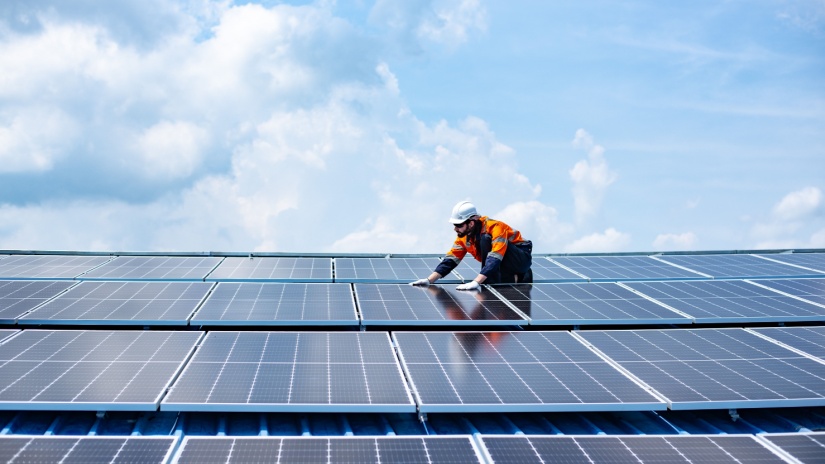Knowledge Centre
How to connect your solar panel to your battery

Are you thinking about going solar or expanding your existing solar setup? Connecting a solar panel to a battery is a key step in storing the sunshine you collect for later use - powering your home even when the sun goes down.
Whether you’re setting up a caravan system, going off-grid, or just want to get the most from your solar panels, this guide will walk you through the process in a way that’s clear, simple, and (dare we say) fun.
Let’s dive into how to safely and effectively connect your solar panel to your battery, the components you'll need, and why thousands of Aussies are making the move to solar power every year.
What you need to connect a solar panel to a battery
To safely connect a solar panel to a battery, you’ll need a few key components. You can’t just run a wire from your panel straight to your battery - that could overcharge it or even cause damage. Here’s what your solar setup should include:
- Solar panel. Converts sunlight into electricity.
- Solar charge controller. Regulates the power from your solar panel before it reaches your battery.
- Battery. Stores energy for later use.
- Wires and connectors. Preferably insulated and rated for your system’s voltage.
- Fuse or circuit breaker. Protects your system from short circuits or overloads.
Step-by-step: How to connect your solar panel to your battery
1. Place your solar panel in full sun
First, make sure your solar panel is in a location where it will receive maximum sunlight during the day - ideally facing north in Australia for best performance.
2. Connect your charge controller to the battery
This is crucial - always connect the solar charge controller to the battery first. Most controllers will turn on and initialise when connected to battery power.
Pro tip: Your charge controller should have three input sections:
- Battery terminals (usually marked BATT or a battery icon)
- Solar panel terminals (PV or solar icon)
- Load terminals (for powering devices directly)
3. Connect the solar panel to the charge controller
Next, connect your solar panel to the solar input terminals of the controller. The controller will now regulate the energy flow to safely charge your battery.
4. Check the status indicators
Most charge controllers will have an LED display or screen showing the system’s status. This includes current voltage, battery charge level, and solar input. Make sure everything is reading as expected.
5. Secure your connections
Ensure all terminals are tightened properly, wires are insulated, and the system is safe from water or dust. If you're setting up a permanent solution, consider housing your charge controller and battery in a weather-resistant box.
Why do you need a charge controller?
Good question! A solar charge controller prevents:
- Overcharging your battery (which can damage it permanently)
- Over-discharging (which reduces its lifespan)
- Voltage spikes or electrical irregularities
Skipping this component is like going on a road trip without brakes - it just won’t end well.
Benefits of switching to solar power in Australia
If you’re thinking about setting up solar at home or on the road, now’s a great time. Australia is blessed with heaps of sunshine, and solar technology is more affordable than ever.
Here are some bright benefits:
- Lower electricity bills – Slash your power bill or eliminate it altogether
- Clean, renewable energy – Reduce your carbon footprint by using the sun
- Battery storage – Store power for night-time or blackouts
- Energy independence – Less reliance on the grid and energy retailers
- Government rebates – Many states and territories offer rebates or feed-in tariffs
With solar batteries now more accessible and cost-effective, you can store more of your own energy and sell the excess back to the grid.
Which Australian energy providers offer solar plans?
Many Aussie energy retailers offer solar-friendly plans that reward you for generating your own energy. These include:
- Origin Energy – Offers solar installation, monitoring, and high feed-in tariffs
- AGL – Competitive solar feed-in rates and solar battery bundles
- EnergyAustralia – Home solar and battery systems with flexible billing
- Tango Energy – Popular in VIC for solar-inclusive plans
- Red Energy – 100% Aussie-owned with solar-friendly billing
- Powershop – Green-focused and solar-compatible, with digital tracking tools
- Dodo – Budget-friendly solar plans with feed-in tariffs across several states
Each provider offers different solar feed-in tariffs, which is the amount you’re paid for excess electricity you send back to the grid. Finding the right match for your solar usage can mean bigger savings long-term.
Need help choosing the best solar energy plan?
Hooking up your solar panel to your battery is just the start. Want to make sure you're not losing money by sticking with an old plan?
That’s where we come in.
Call Compare Energy on 1300 790 106 and let us do the heavy lifting. We’ll compare Australia’s top energy retailers to find a solar plan that suits your system, location, and lifestyle - for free. No jargon, no pressure, just smart energy advice from Aussies who get it.
Let’s harness the sun and power your future.

